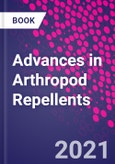Advances in Arthropod Repellents offers the most current knowledge on arthropod repellents. This area of study is quickly evolving as mosquito- and tick-borne diseases become more prevalent worldwide. Written by global arthropod repellent experts, this book begins by delving into molecule discovery and assay development that is followed by the latest research and investigations of repellent developments and effects. The book then offers readers a look into the global field, semi-field, and laboratory trials using various insect repellents, ranging from Africa, Australia, Europe, South America and the United States. Lastly, it examines the future of spatial repellents and expert insight.
This book is a valuable resource for entomologists and vector control researchers and practitioners. Public health officials and developers in private pest control companies, as well as readers in academia will find this a useful resource to learn the latest information available on controlling the spread of arthropod-borne diseases with repellents.
Please Note: This is an On Demand product, delivery may take up to 11 working days after payment has been received.
Table of Contents
Part One: Novel Arthropod Repellent Molecule Discovery or Assay Development
1. Introduction: The Role of Arthropod Repellents in Public Health
2. Novel Pyrethroid Derivatives as Effective Mosquito Repellents and Repellent Synergists
3. Biorational Compounds as Effective Arthropod Repellents Against Mosquitoes and Ticks
4. Evaluating Techniques and Efficacy of Arthropod Repellents Against Ticks
5. Evaluation and Application of Arthropod Repellent Treated Uniform/Clothing and Textiles Against Vectors
6. Repelling Mosquitoes with Electric Fields
Part Two: Mechanism of Arthropod Repellent Research and Development
7. Multimodal Mechanisms of Repellency in Arthropods
8. Finding a Repellent Against Ticks: Neurophysiological and Behavioral Approaches
9. Arthropod Repellents and Chemosensory Reception
Part Three:� Conducting Arthropod Repellent Studies in Field and Semi-field Trials
10. Semi-field Bioassays for the Evaluation of Spatial (and Topical) Arthropod Repellents for Indoor and Outdoor Use
11. Semi-field Evaluation of Arthropod Repellents: Emphasis on Spatial Repellents
12. Human Subject Studies of Arthropod Repellent Efficacy
13. Arthropod Repellent Research in Northwest Florida
Part Four: The Current Status and Future Uses of Arthropod Repellents
14. The Current Status of Spatial Repellents in the Global Vector Control Community
15. Repellent Semiochemical Solutions to Mitigate the Impacts of Global Climate Change on Arthropod Pests
16. The Role of Arthropod Repellents in the Control of Vector-Borne Diseases








